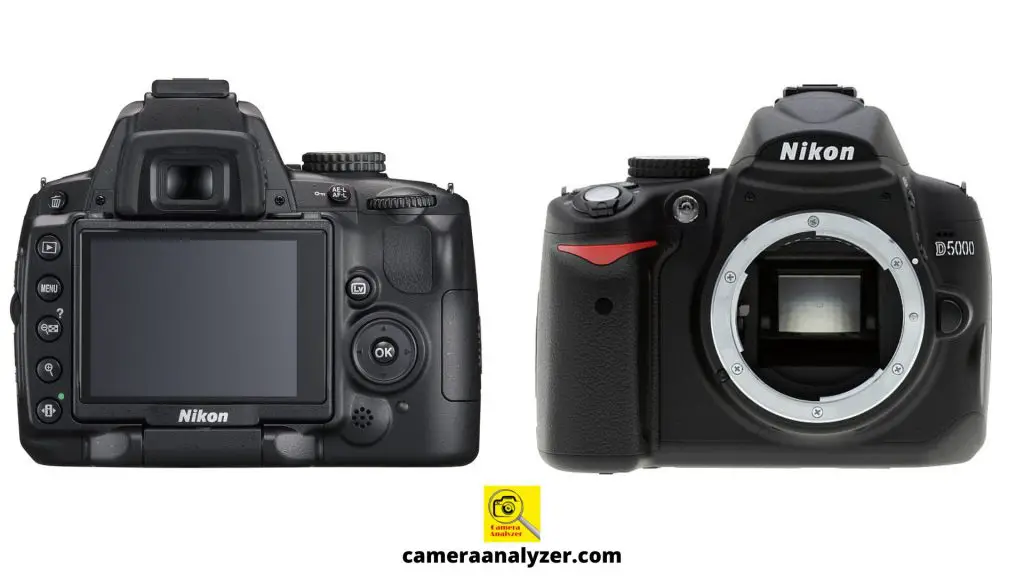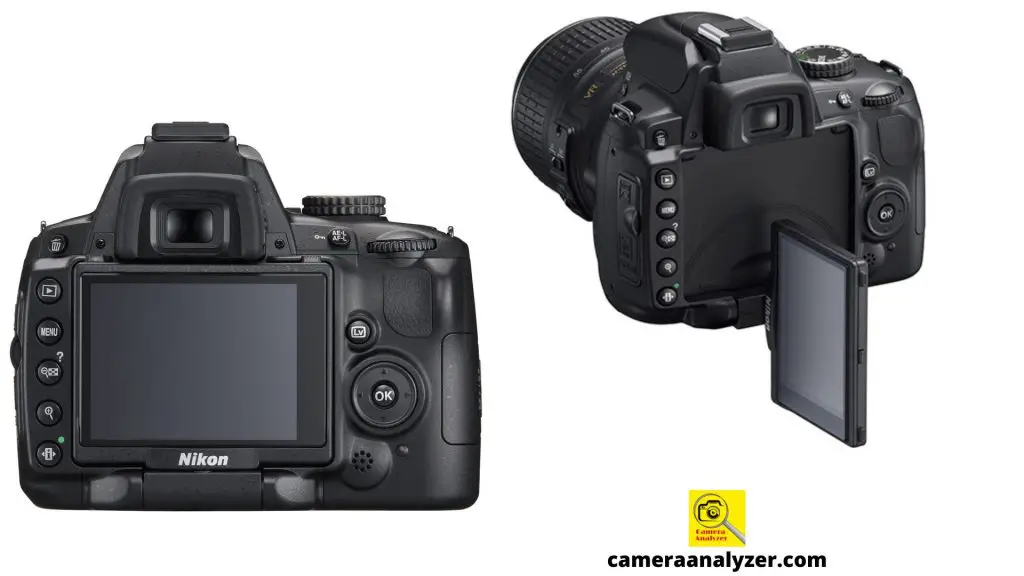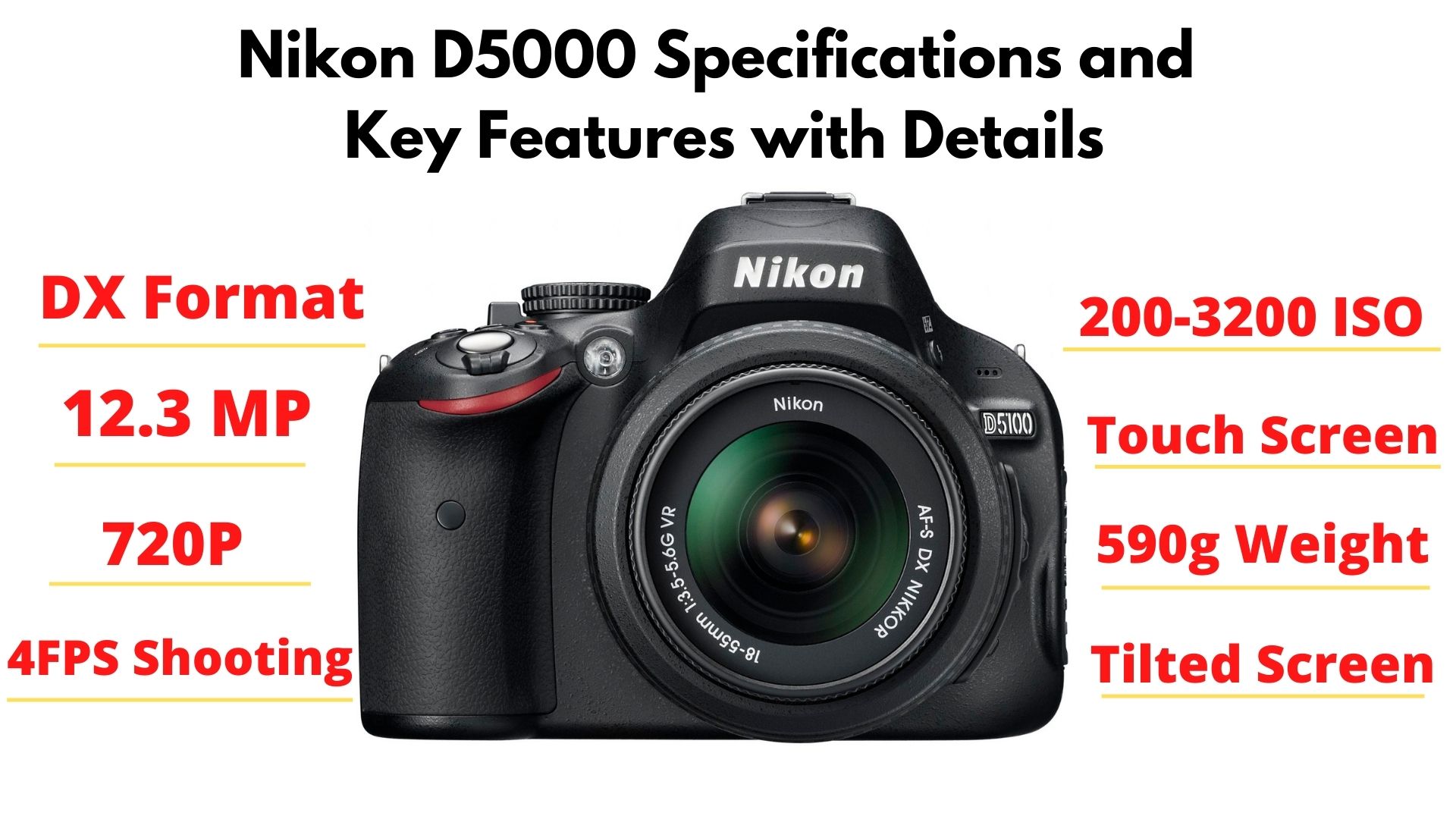A summary, as well as a brief explanation of the Nikon D5000 specifications and key features with details, are listed in this article. If you read this article till last, you’ll have a total overview of the Nikon D5000, despite not having the camera in your hands.
Key Features
- 12.3-megapixel DX-format CMOS image sensor
- D-Movie Mode with sound
- Vari-angle color LCD monitor
- 19 Auto-exposure Scene Modes
- One-button Live View
- Continuous shooting as fast as 4 frames per second
- Low noise ISO sensitivity from 200 to 3200
- Built-in image sensor cleaning
- 11-point Autofocus System with 3D Focus Tracking
- Auto Active D-Lighting
- In-camera Retouch image editing
- Picture Control Settings for personal image control
- Nikon 3D Color Matrix Metering II
- Durable, high-precision shutter
- GPS Geo-tagging
Replaced: Nikon D60
Replaced By: Nikon D5100
Advantages and Disadvantages
These are the advantages of disadvantages of the Nikon D5100. This can also be referred to as what reviewers, as well as users, like and dislike.
Advantages
These are the advantages of the Nikon D5000:
- Articulating Screen
- Optical Built-in Viewfinder
- Face Detection Focusing
- 11 Focus Points
- Long Battery Life (510 shots)
- 590g Light Body
- Timelapse Recording
- Flash Sync Port
- Selfie & Vlogger Friendly LCD Screen
Disadvantages
These are the disadvantages of the Nikon D5000:
- No Wireless Connection
- No Full HD Video
- No Touch Screen
- Max Sensitivity only ISO 3200
- No Environmental Sealing
- Not so wide AE Bracketing Range: ±2 EV
- No AF Micro Adjustment
Read Also: Nikon D5600 Specifications and Key Features
General
| Brand | Nikon |
| Model | D5000 |
| Type | Single-lens reflex digital camera |
| Release Date | 2009-06-12 |
| Body Type | Compact DSLR |
Launched in June 2009, the Nikon D5000 is an entry-level 12.0MP DSLR camera featuring a fully articulated screen, APS-C (23.6 x 15.8 mm) sized CMOS sensor and Nikon F lens mount. This model took the place of the earlier Nikon D60, and the Nikon D5000 was eventually superseded by the Nikon D5100.
Dimensions and Weight
| Dimensions (W x H x D) | Approx. 127 x 104 x 80 mm (5.0 x 4.09 x 3.15 in.) |

The Nikon D5000 measures 127 x 104 x 80 mm (5 x 4.09 x 3.15′′) and weighs 590 g (1.30 lb / 20.81 oz). The Nikon D5000 is a remarkably light camera for its class, especially when you consider that the average weight of DSLR-type cameras is 773g. With a thickness of 80mm, it has an average thickness for its class.
Photography Features
| Min Shutter Speed | 30s |
| Max Mechanical Shutter Speed | 1/4000s |
| Continuous Shooting | 4.0 fps |
| Shutter Priority | YES |
| Aperture Priority | YES |
| Manual Exposure Mode | YES |
| Exposure Compensation | YES |
| Custom White Balance | YES |
| Image Stabilization | NO |
| Built-in Flash | YES |
| Flash Range | 17.00 m (at ISO 100) |
| Max Flash Sync | 1/200s |
| Flash Modes | Auto, On, Off, Red-eye, Slow sync, Rear-curtain |
| External Flash | YES |
| AE Bracketing | YES |
| WB Bracketing | YES |
Video Features
| Video Resolutions | 1280 x 720 (24 fps), 640 x 424 (24 fps), 320 x 216 (24 fps) |
| Max Video Resolution | 1280 x 720 |
| Video Formats | Motion JPEG |
| Microphone Port | NO |
| Headphone Port | NO |
Image Sensor
| Sensor Type | CMOS |
| Sensor Size | APS-C |
| Sensor Dimension | 23.6 x 15.8 mm |
| Sensor Area | 372..88 mm2 |
| Sensor Resolution | 12MP |
| Effective Pixels | 12.3 Million |
| Maximum Native ISO | 3200 |
| Maximum Boosted ISO | 6400 |
| Minimum Native ISO | 200 |
| RAW Support | YES |
The 12.9-megapixel CMOS sensor in the Nikon D5000 is claimed to be the same as the one in the Nikon D90. It measures 23.6 x 15.8mm and has an effective resolution of 4,288 x 2,848 or 12.3 megapixels. The only information Nikon provides regarding the processors employed in each camera is the name of the system: the Expeed Image Processing System. It is evident by looking at the D5000’s photographs, particularly the high ISO ones, that whatever the Nikon D5000’s Expeed system is made of, it functions rather effectively.
Read Also: Nikon D5500 Specifications and Key Features
Nikon D500 DxOMark Sensor Scores
DxOMark is a benchmark for evaluating the image quality of camera sensors scientifically. DxO Mark evaluated the Nikon D5000 sensor, awarding it an overall score of 72 for picture quality. The specifics of their examination of the Nikon D5000 are available here.
Compatible Lenses
| Manual Focus | YES |
| Lens Mount | Nikon F |
| Number of Lenses | 316 |
| Focal Length Multiplier | 1.5x |
| Macro Focus Range | n/a |
There are presently many native lenses that can be used with the Nikon D5000’s Nikon F lens mount. Nikon F mount has one of the widest selections of lenses and has backward compatibility, allowing you to use lenses dating back to the 1960s. Additionally, it is highly supported by lenses made by independent producers.
The Nikon D5000 has a minor drawback in that it lacks an internal focus motor, making it incompatible with older screw-drive autofocus (AF) lenses. With contemporary Nikon AF-S, AF-I, and G lenses, it continues to function properly, while lenses from the 1980s may not autofocus on the Nikon D5000.
Best Lenses for Nikon D5000
- Nikon 24-120mm f4G ED VR
- Nikon 35mm f1.8G
- Tamron 150-600mm f5-6.3 VC
- Sigma 8mm F3.5 EX DG Fisheye
- Nikon Micro-105mm f2.8G IF-ED VR
Read Also: Nikon D5300 Specifications and Key Features
Viewfinder
| Viewfinder | Optical (pentamirror) |
| Viewfinder Resolution | no electronic viewfinder |
| Viewfinder Coverage | 95% |
| Viewfinder Magnification | 0.52 |
The built-in optical (pentamirror) viewfinder of the D5000 makes it simpler to take pictures in bright sunshine and other conditions where it would be challenging to see the LCD panel. The viewfinder features a 0.52x magnification ratio and 95% coverage. 95% coverage indicates that the image you see while shooting will be slightly different from what you see in your viewfinder.
Storage
| Storage media | SD memory cards, SDHC compliant |
| Storage Slots | 1 |
Images from the Nikon D5000 are kept on SD cards, which currently have a 32GB capacity. Modern SD cards are quite quick, if not quite as fast as the most recent UDMA CompactFlash cards, and they offer plenty of storage. Additionally, SD cards are a little more durable and less likely to result in bent contact fingers in the camera or a card reader blocking the card connector and rendering the camera inoperable.
Monitor Screen
| Screen Type | Fully articulated Type |
| ScreenTechnology | TFT LCD |
| Screen size | 2.70 inch |
| Screen resolution | 230k dots |
| Live view | YES |
| Frame coverage | 100% |
| Brightness Adjustment | YES |
| Touch screen | NO |
A Fully Articulated 2.70-inch LCD screen with 230k dots of resolution is featured on the Nikon D5000. When opposed to just tilting or fixed screens, articulated screens are more video-oriented. However, people who are interested in photography tend to like tilting screens. The screen is smaller than most contemporary models in this class, measuring only 2.70″, and its 230kdot resolution is inferior.

Because of its Selfie-friendly screen, the Nikon D5000 will make life easier for those of you who enjoy taking individual or group selfies. Vloggers and any other single-person video production teams will also benefit from the LCD screen on the D5000.
Read Also: Nikon D5200 Specifications and Key Features
Autofocus
| AF Touch | NO |
| AF Continuous | YES |
| AF Sigle | YES |
| AF Tracking | NO |
| AF Selective | YES |
| AF Centre | NO |
| AF Multi-view | YES |
| AF Live view | YES |
| AF Face Detection | YES |
| AF Contrast detection | YES |
| AF Phase detection | YES |
| Number of focus points | 11 |
Although the Nikon D5000’s phase-detect autofocus speed performed admirably in our lab tests, producing shutter lag numbers of 0.27 for single-point AF and 0.35 for auto-area AF at a wide angle, I experienced significant AF lag when shooting indoors in low light conditions, especially when using Wide-area AF mode.
Our initial thought was that it might be the kit lens’s f/3.5 maximum aperture, but the AF-S 35mm f/1.8G gave us the same issue, occasionally taking two seconds or longer to decide. The AF-assist lamp on the Nikon D5000 is wonderful, but it doesn’t help speed up the process much. Though it is slower in auto-area AF, the Canon XTi I have nearby is still noticeably faster in both settings.
It becomes worse in Live View mode, which employs contrast-detect focusing. We took, on average, 2.3 seconds to focus in the lab. That’s not very good. Camera movement makes it worse, thus adding a VR lens does help, albeit not significantly.
When using the Nikon D5000’s live view, a tripod is recommended so you may move the AF point around and let the camera operate slowly and steadily. Customers should be aware that the Nikon D5000 focuses much more slowly in Live view than their typical all-in-one digital camera. You’ll be content if you adjust your expectations accordingly.
Video Recording
| Video Resolutions | 1280 x 720 (24 fps), 640 x 424 (24 fps), 320 x 216 (24 fps) |
| Max Video Resolution | 1280 x 720 |
| Video Formats | Motion JPEG |
| Microphone Port | NO |
| Headphone Port | NO |
You may record films with the Nikon D5000 at a maximum resolution of 1280 x 720 at 24 frames per second and save them in Motion JPEG format. By today’s standards, 1280 x 720 is a modest video resolution.
Read Also: Nikon D7500 Specifications and Key Features
With the Nikon D5000, autofocusing is not possible when you are filming a movie, in contrast to the Canon T1i. Though the T1i’s focusing attempts, which frequently involve major adjustments to the exposure as well as focus when autofocusing, must be removed during editing, it’s not a huge loss because I’d rather not have to do that.
It’s simple enough to manually focus if the AF switch on the lens is disabled. As long as your subject has adequate information, the onscreen image is also sharp enough for you to typically be able to see the plane of focus as you make your adjustments.
Connectivity
| Wireless Connectivity | Eye-Fi Connected |
| HDMI | YES |
| USB | USB 2.0 (480 Mbit/sec) |
I was happy to learn that an HDTV can display a Live view image using the Mini-HDMI out connector. From there, you may play back still images and movies as well as access the menu. I’m not sure if the video playback is “broadcast quality,” but it appears decent and is sharper than I’ve seen from other, smaller digital cameras. But it’s unquestionably adequate for home movies.
The three ports on the Nikon D5000, two of which are new, are visible on the left: The GP-1 GPS unit or an MC-DC2 wired remote can be connected to the Accessory terminal on top. Below are the Mini-HDMI and USB/AV connector ports. The Nikon D5000 does not come with a Mini-HDMI cable.
Exposure
| Exposure metering | 3D Color Matrix Metering II, Center-Weighted and Spot Metering |
| Exposure modes | Auto modes (auto, auto [flash off]), Advanced Scene Modes (Portrait, Landscape, Child, Sports, Close up, Night portrait, Night landscape, Party/indoor, Beach/snow, Sunset, Dusk/dawn, Pet portrait, Candlelight, Blossom, Autumn colors, Food, Silhouette, High key, and Low key), programmed auto with flexible program (P), shutter-priority auto (S), aperture-priority auto (A), manual (M) |
Photography Features
| Min Shutter Speed | 30s |
| Max Mechanical Shutter Speed | 1/4000s |
| Continuous Shooting | 4.0 fps |
| Shutter Priority | YES |
| Aperture Priority | YES |
| Manual Exposure Mode | YES |
| Exposure Compensation | Yes |
| Custom White Balance | YES |
| Image Stabilization | NO |
| Built-in Flash | YES |
| Flash Range | 17.00 m (at ISO 100) |
| Max Flash Sync | 1/200s |
| Flash Modes | Auto, On, Off, Red-eye, Slow sync, Rear curtain |
| External Flash | YES |
| AE Bracketing | YES |
| WB Bracketing | YES |
It’s crucial for enthusiasts to be aware that, unlike the Nikon D90, the Nikon D5000’s pop-up flash cannot act as a commander flash for external SB-600, SB-800, or SB-900 flashes. To operate other flashes, an SB-800 must be mounted. With the Nikon D40, D40x, and D60, this is also accurate.
Read Also: Nikon D3500 Specifications and Key Features
Power Source
| Power sources | One Rechargeable Li-ion Battery EN-EL9a, AC Adapter EH-5a |
The EN-EL9a, a 7.2V 1080mAh lithium-ion battery pack, is an improved version of the battery used by the Nikon D40 and D60 and is included with the Nikon D5000. The older 1000mAh EN-EL9 battery is also backward compatible with the D5000. According to the CIPA standard, the Nikon D5000 can take 510 pictures with an upgraded battery. A power cord and the MH-23 Nikon Quick Charger are also included with the camera.
Conclusion
Nikon D5000 specifications and key features have made it clear that this camera can be used by an extremely beginner photographer. The camera provides only essential features for photography and the video features are not up to the level of today’s requirements.

